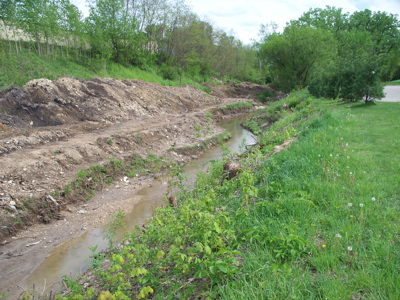Encyclopedia Dubuque
"Encyclopedia Dubuque is the online authority for all things Dubuque, written by the people who know the city best.”
Marshall Cohen—researcher and producer, CNN
Affiliated with the Local History Network of the State Historical Society of Iowa, and the Iowa Museum Association.
STORM WATER MANAGEMENT
STORM WATER MANAGEMENT. The primary function of the City of Dubuque's stormwater management program was to manage storm water where it falls. This included passing storm water through the property or simply managing the storm water that originated on the property.
Limestone sewers were erected in the late 1880s to early 1900s. Constructed with the intent of carrying off rainwater, the sewers often received "dishwater and all kinds of filth thrown promiscuously into the alleys." The result was described as:
Coming down 8th Street a few evenings ago, a smell
came up that made one think he was in a fertilizer
factory or a last year's packing house. (1)
In 1992 nearly $100,000 was budgeted for upkeep of these sewers which were still used. (2)
Annually storm water management projects and programs were identified in the five year Capital Improvement Program (CIP) budget to maintain and improve the City's existing drainage system. Projects ranged from the construction of new detention basins and the extension of storm sewer systems to the rehabilitation of existing storm sewer systems. Programs ranged from public ditch, storm sewer, and detention basin maintenance to a program to maintain and improve the water quality of storm water runoff. Although there were large diameter storm sewers, approximately 80 were only 15-inch in diameter.
Many drainage problems were of a localized nature, involving the drainage of only a few residences. However, due to a growing number of citizen complaints, the City Council authorized the development of a Drainage Basin Master Plan (DBMP) for two of the major watersheds - the North Fork Catfish Creek and Bee Branch drainage basins. The DBMP determined that approximately 1,150 homes and businesses were at risk of flood damage during heavy rains and it recommended a series of improvements in both watersheds.
The City of Dubuque adopted a storm water detention policy in the early 1990s to prevent developments from creating new flooding problems.
North Fork of Catfish Creek
See: BEE BRANCH
---
Source:
1. "Stifle the Stink," Dubuque Daily Herald, August 17, 1890, p. 4.
2. Japson, Bruce. "Experts Urge Cities to Examine Tunnels," Telegraph Herald, April 19, 1992, p. 1. Online: https://news.google.com/newspapers?nid=aEyKTaVlRPYC&dat=19920419&printsec=frontpage&hl=en
[[Category:




